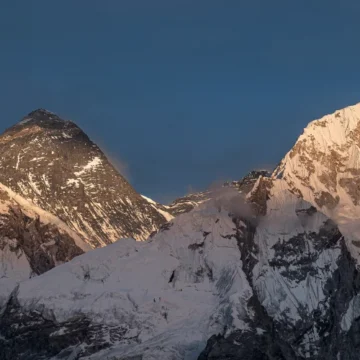
How Many Days to Climb Mount Everest?

Table of Contents
People worldwide dream of climbing Mount Everest, considering it one of the most thrilling adventures imaginable. Although it’s hazardous, some brave individuals are examples of other climbers.
Some climbers have achieved extraordinary feats, such as climbing Everest without supplemental oxygen. We all must be wondering how many days does it takes to climb Mt Everest.
The time required to climb Everest varies, but typically, it takes around two months (60-65 days) to complete the ascent. How many days does it take to climb Everest? This question drives the planning and determination of those aiming to conquer the world’s highest peak.
The journey is filled with challenges, including extreme weather conditions and the need to acclimatize to high altitudes. Climbers must be prepared for a demanding and lengthy expedition.
How many days does it take to climb Mount Everest?
So, how many days does it take to climb Mount Everest? Climbing Mount Everest typically takes about two months. This includes time for acclimatization, rest days, and the actual ascent to the summit.
Climbers spend several weeks acclimatizing at various camps along the route to avoid altitude sickness and prepare their bodies for the extreme conditions they will face at higher altitudes.
Climbing Mount Everest: Nepal or China?
When it comes to climbing Mount Everest, adventurers have the option of choosing between the Nepalese and Chinese sides. The southern route from Nepal is the more popular choice, as it is considered less challenging than the northern route from China.
Both sides offer unique experiences, but Nepalese are favored for their relatively easy ascent.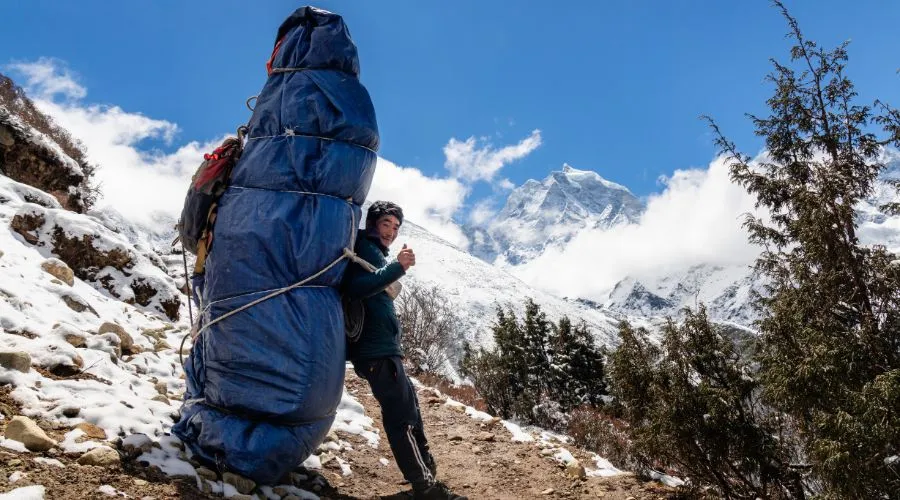
Porter posing for a photo at Everest Base Camp Trek.
Ever thought about how long to climb Everest from base camp? The journey to summit Mount Everest from the southern side starts with several days of acclimatization at the Everest Base Camp in Nepal.
During this time, climbers gradually ascend to Camp 1 and then return to base camp to adjust to the altitude. This process is repeated to help the body adapt to the high altitude.
When it’s time for the summit attempt, climbers begin from Camp 3. From there, they head towards the South Col, a pass between Everest and Lhotse. At the South Col, climbers take an extended break to prepare for the final push to the summit.
Minimizing the time spent above 8000 meters is crucial to reduce the risk of altitude sickness. It takes approximately nine to eighteen hours from the South Col to reach the summit.
Some climbing teams spend a night at the South Col before attempting the summit. However, this requires additional oxygen supplies for three days. Without supplemental oxygen, staying at such high altitudes is extremely dangerous, as the body struggles to function properly without enough oxygen.
South Col to Balcony
After reaching the South Col, climbers start a roughly four-hour journey to the Balcony, a key point along the route. At the Balcony, climbers typically take a well-deserved break lasting about half an hour.
Following this rest, they continue their ascent toward the South Summit, which usually takes around two and a half hours. Upon reaching the South Summit, climbers often pause for another enjoyable break, lasting approximately half an hour.
From the summit, climbers conquer the Hillary Step, which typically takes about an hour to reach the South Summit. After defeating this challenging section, climbers begin their descent.
Descending from the summit takes approximately half an hour. Subsequently, climbers descend to the Balcony, which usually requires about two hours. Remarkably, the journey back from the Balcony to the South Col is relatively swift, only around an hour.
Many Everest climbers spend the night at the South Col after successfully summiting Mount Everest. However, some teams choose to descend to Camp 2 overnight. Laying at Camp 2 eliminates the need for supplemental oxygen, reducing climbing costs to some extent.
How long is the hike up to Mount Everest?
Have you ever thought how long is the Everest hike? The hike to Mount Everest Base Camp, the starting point for climbers, is around 65 kilometres (40 miles) one way. So this is the distance of how many days to climb Mount Everest. This trek usually takes about 10 to 14 days, depending on the route and the pace of the hikers.
The hike is challenging due to the high altitude and rugged terrain, but it offers stunning views of the Himalayas and the opportunity to experience the unique culture of the region.

The Base Camp In China
How many days to climb Mt Everest? People want to know how many days to set aside for the challenging climb to Everest’s summit. The base camp on the Tibetan side of Mount Everest, while less favoured for climbing compared to the Nepalese side, still attracts some trekkers seeking a different perspective.
Climbers attempting Everest from the Tibetan side should know that the Chinese border can unexpectedly close, contributing to the Nepalese route’s higher popularity.
On the Tibetan side, climbers can drive to Everest Base Camp, facilitated by the China Tibet Mountaineering Association (CMA). The journey to the base camp from Lhasa, the capital of Tibet, typically takes around 5 to 6 days. This route offers a distinct experience and allows climbers to appreciate the mountain differently.
One advantage of the Tibetan route is the ability to drive directly to the base camp, which can be more convenient for some climbers. Additionally, the Tibetan side offers a less crowded and more tranquil experience than the bustling Nepalese side.
However, climbers should be prepared for the challenges of the Tibetan route, including the potential for sudden border closures and the need for proper permits and permissions from the Chinese authorities.
How long does it take to get to the top of Mount Everest?
People often inquire how many days to climb Mt Everest. The time it takes to reach the summit of Mount Everest varies depending on the weather, the climber’s physical condition, and other factors.
On average, climbers spend about two months on the mountain, with the final push to the summit typically taking place in late May or early June when the weather is most favourable. The actual ascent from the highest camp to the summit can take 9 to 18 hours, depending on the climber’s speed and stamina.
How long it takes to climb Everest?
Many people always wonder one question: how many days does it take to climb Mount Everest? Usually, it takes around 60-66 days to climb Mount Everest. This answers how many days you need to climb Mount Everest.
But it might take even more or less. It depends on the physical and mental fitness of the Everest Climber. Many Sherpa people of Nepal and some foreign climbers have climbed Everest in less than 60 days. Some even have climbed in less than two days. But they are real professional climbers.
For those preparing to summit Everest, it’s crucial to understand the role of acclimatization, rest, and precise climbing. These factors are not just important; they are essential for a successful climb.
Why does it take so long to climb Mount Everest?
For those considering the challenge, how many days to climb Mount Everest? Climbing Mount Everest is a challenging feat that requires careful planning and preparation. Trekking to the Everest base camp is much more complex and demanding than the summit.
The harsh weather, extreme temperatures, and challenging terrain make it a formidable climb. One of the critical aspects of climbing Everest is acclimatization, which involves gradually getting used to the high altitude to avoid altitude sickness.
The climbing season for Everest typically begins in late March, starting from the base camp on the southern side of Everest in Nepal, which is at an altitude of 5,300 meters.
This side of Everest is the most popular for climbers due to its accessibility and relatively safer climbing conditions. However, climbers still face challenges, such as navigating through icy terrain and shifting glaciers.
Summit attempts usually start at midnight, with climbers acclimatizing at various camps. They spend 4 to 5 days acclimating at the base camp before going to Camp 1, which is halfway above the Khumbu glacier. After reaching Camp 1, climbers acclimate for a few more days before continuing their ascent.
Ascending and acclimatizing to the high altitude takes a long time. Climbers must make their way carefully, as the journey to the summit is extremely dangerous. Once they reach an altitude above 7925 meters, known as the “Death Zone,” the risk factor becomes very high. This is why a lengthy duration is necessary for the ascent.
In this zone, the air is so thin that it can lead to severe altitude sickness and even death if not appropriately managed. Climbers must acclimate slowly to reduce the risk and allow their bodies to adjust to the altitude.
This involves climbing to higher camps and descending back to lower altitudes to rest and recover before ascending again. The process requires patience, perseverance, and careful planning to ensure a safe and successful climb.
The Mt Everest Climbing Season
When considering how long it takes to climb Everest from base camp, factors like weather, acclimatization, and physical condition play a crucial role. The ideal time for climbing Mount Everest is during the spring, from April to May when the weather conditions are most favourable.
Climbers typically begin their expeditions in late March to take advantage of the optimal climbing conditions. The journey to summit Everest and return usually spans around two months, totalling approximately 64 days.
This extended duration allows climbers to tackle the challenges of the climb at a steady pace while ensuring they have ample time to acclimate to the high altitude.
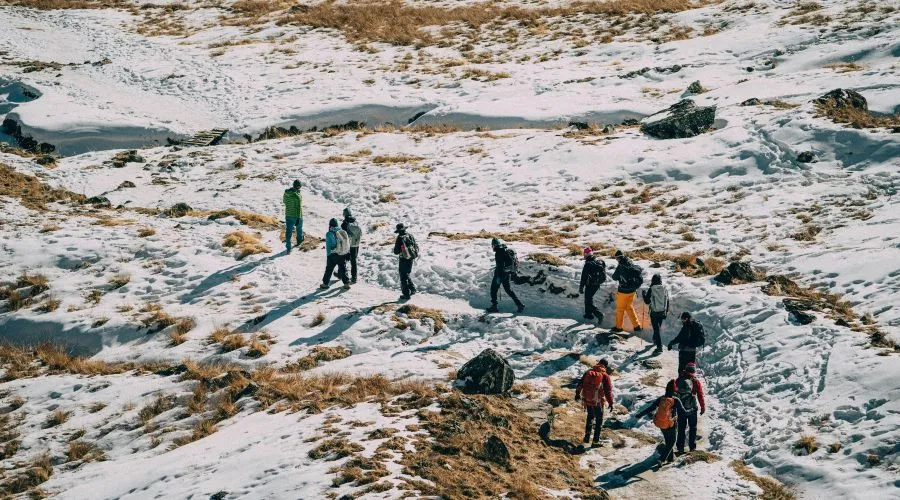
During the spring season, climbers can expect relatively good weather conditions, which significantly contribute to their comfort and safety during the ascent.
The clear skies and mild temperatures make the climbing experience more manageable, allowing climbers to focus on the task without the added burden of extreme weather conditions.
Conversely, attempting to climb Everest during other months of the year presents numerous challenges and risks. Dense fog, heavy snowfall, and strong winds make climbing exceedingly tricky and hazardous.
These adverse weather conditions check progress and increase the likelihood of accidents and mishaps.
Regardless of the time of year, the summit of Everest remains perpetually cold and unfriendly. Even during the peak climbing season, climbers must contend with freezing temperatures and harsh conditions, making the final push to the summit a formidable challenge.
However, the favourable weather conditions during the spring months provide climbers with the best opportunity to conquer the world’s highest peak safely and successfully.
How long does it take to climb Mount Everest from base camp?
The question of how many days it takes to climb Mt Everest is a common one among climbers and adventurers. Climbing Mount Everest from base camp typically takes about 50 to 60 days.
This includes time for acclimatization rotations, during which climbers spend time at higher altitudes to prepare their bodies for the thin air near the summit.
Climbing Mount Everest how long does it take? The actual ascent from base camp to the summit usually takes about 10 to 14 days, depending on the weather and the climber’s physical condition. Climbers often spend several days at higher camps, resting and waiting for the right conditions before making their final push to the top.
How hard is it to climb Mt. Everest?
Climbing Mount Everest is incredibly challenging, one of the most difficult undertakings you can imagine. When you climb Everest, you ascend to extreme altitudes where the air is so thin that breathing without additional oxygen is impossible.
Additionally, the summit of Everest is bitterly cold, requiring you to bundle up in multiple layers of clothing to stay warm.
Despite the numerous hardships and discomforts, climbing Everest is an enriching experience. However, to succeed, climbers must confront the genuine dangers of the climb, including the risk of death, which requires immense courage and determination.
Challenges You Might Encounter While Climbing Mount Everest When attempting to climb Mount Everest, you will likely face numerous challenges that test your physical and mental endurance.
Surprisingly, more than 90 out of 100 climbers fall ill while trying to reach Everest’s base camp. The harsh conditions, including cold temperatures and changing altitudes, often contribute to these illnesses.
Adapting to the Food available in the Everest region can be another challenge. While the food isn’t necessarily unhygienic, many trekkers and climbers experience stomach upsets on their way to the base camp. There will be hotels and lodges for accommodation.
The weather on Everest is highly unpredictable, with strong winds, bad weather, and devastating avalanches posing significant risks. Climbers must contend with these elements while ascending the mountain.
One of the most dangerous obstacles on the climb is the Khumbu Icefall, which has claimed the lives of many climbers. Climbing through this icy and treacherous terrain requires immense courage and skill. Returning safely to the base camp after reaching the summit is crucial to avoid the risks associated with the descent.
Trekking to Everest Base Camp is a popular adventure activity that offers a different experience from climbing the mountain. The trek through the Khumbu region, including Sagarmatha National Park, takes around a week or ten days, depending on acclimatization needs. Some trekkers choose alternative routes, such as the Gokyo route, while others fly to the base camp by helicopter.
Fastest Mount Everest Climb
Lhakpa Gelu Sherpa achieved the fastest climb to Mount Everest. On May 26, 2003, he climbed from the Everest South Base Camp to the summit in 10 hours, 56 minutes, and 46 seconds, using supplemental oxygen.
His record-breaking time shows his strength and skill in climbing high altitudes. Climbing Everest typically takes several days, so doing it in less than 11 hours is truly remarkable.
Phunjo Jhangmu Lama holds the fastest ascent record for women. On May 26, 2024, she reached the summit in 14 hours and 31 minutes. Her climb in just over half a day is an amazing accomplishment that highlights her physical endurance and determination.
Both Lhakpa Gelu Sherpa and Phunjo Jhangmu Lama’s records are extraordinary achievements in the challenging world of mountaineering.

Can you climb Mount Everest alone?
Summiting Everest alone is very dangerous and, in many cases, not recommended, especially with Mount Everest. How many people climb Mount Everest per day? Well, the answer depends on the number of climbers and the traffic at Everest.
Many climbs have been made to the highest point of Mount Everest. Climbers face many problems when climbing Mount Everest, including Weather conditions, avalanches, crevasses, and the possibility of getting high-altitude illnesses.
These are the same dangers that other climbers can encounter when they conquer the mountain alone; it is difficult to find help in moments of need. In addition, most regulation demands that climbers be in a group of a specific team for security reasons and support.
Sherpa are only friends when you are climbing Everest mountain. During the climbing expedition, camps are created, routes are plotted, and make sure medical assistance is available, among other services that are crucial in a successful climb for any team.
Can you climb to the top of Mount Everest?
How many days do you need to climb Mount Everest? It is possible to climb Mount Everest, but it is not an easy task, and it is advisable to undergo some preparations, enhance their physical health, and undergo some practice on the same.
The summit is at 8,848 meters (29,029 feet) over the main level; thus, Mount Everest’s summit is the highest point in the world. Climbers are battling high altitudes, hostile environments, and difficulty with wall climbing. How many weeks does it take to climb Mount Everest?
It takes several weeks to stage the climb, where the climbers move up and down the mountain to acclimate to the high altitude. Still, where there is the will, there is a way, and for those willing to prepare and be supported, reaching the summit of Mount Everest is well and truly within their sights.
Bear Grylls Mount Everest climb

Has Bear Grylls climbed Mount Everest? Yes, Bear Grylls climbed Mount Everest in 1998 at the age of 23, becoming one of the youngest Britons to do so. During the climb, he confronted hardships following blizzards and a fatal fall into a crevasse.
However, Bear was not to be discouraged, and he pulled through to the top using his pioneering skills. This feat not only demonstrated his athletic endurance but also went on to assert his physical and mental strength as an adventurer.
Everest remains one of the most significant landmarks that Bear Grylls has ever accomplished, proving how he overcomes every obstacle.
Can you climb Mount Everest in a day?
Many people are eager to know if you can climb Mount Everest in a day. Conquering Mount Everest in a day is quite impossible because of altitude issues and appropriate acclimatization.
Other climbers’ record-setting time at Mount Everest are exceptions, including Lhakpa Gelu Sherpa’s eleven-hour climb, which involved climbing from base camp to the summit with bottled oxygen.
However, such records are set by professional climbers and under certain conditions and do not in any way describe a normal climbing activity.
Reaching the summit from the high camps takes a couple of weeks. This time is spent in various camps on the mountain, allowing one’s body to adapt to the thin air. How many days does it take to climb Mount Everest?
The actual top-summiting, commonly termed the summit from the highest camp, usually lasts about 12 to 18 hours. Acclimatization is the key to getting to the top of Mt. Everest safely.
Want to know more?
Speak to an Expert





Sandip Dhungana
Nepal 🇳🇵
Whatsapp: +977-9823636377



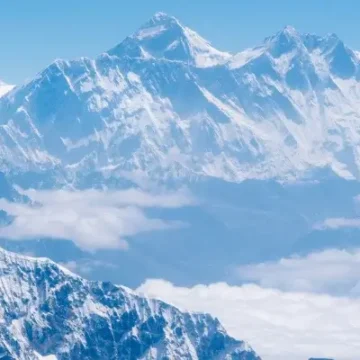
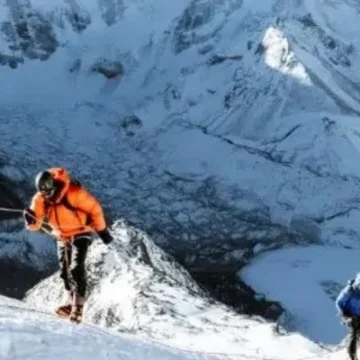
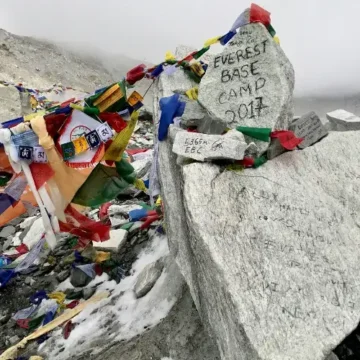
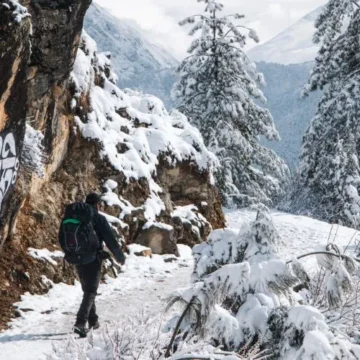

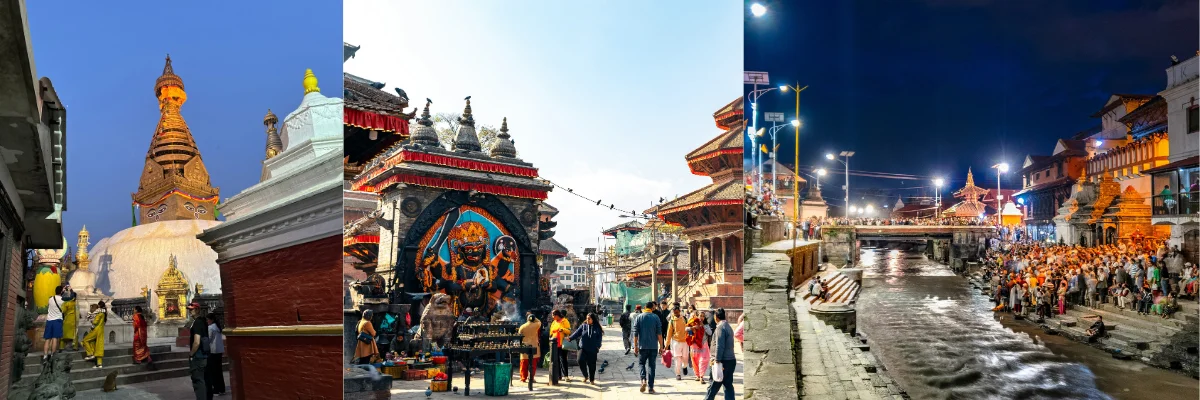
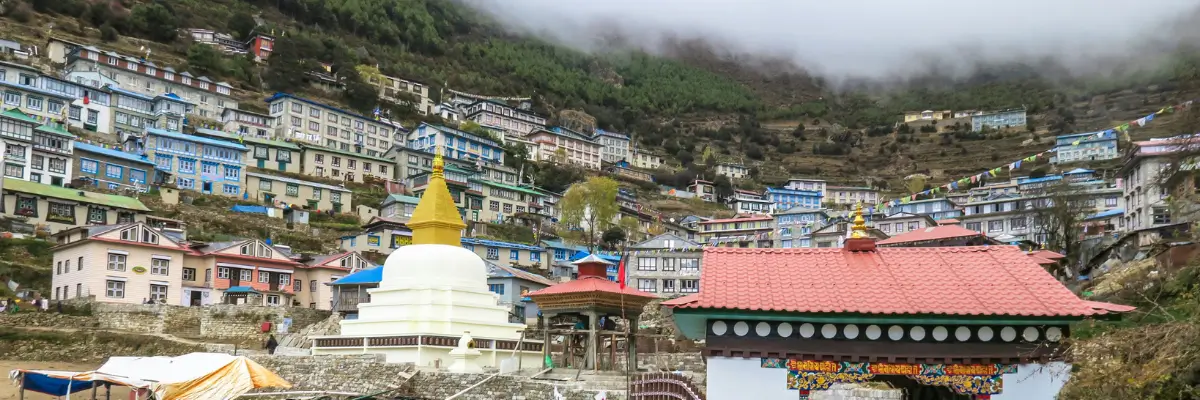














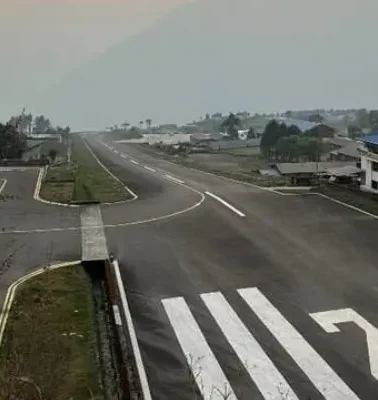
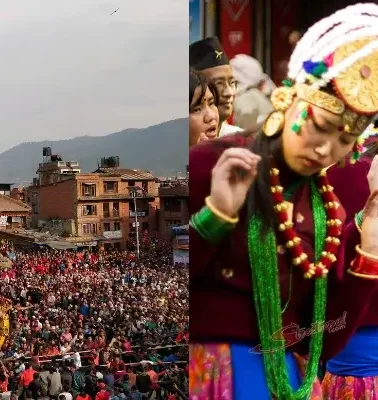
COMMENTS(2)
Amazing. But l would like Everest to have more rest! Too commercialized. Instead of ego trip a glorious mountain to afmire.
That would be great.